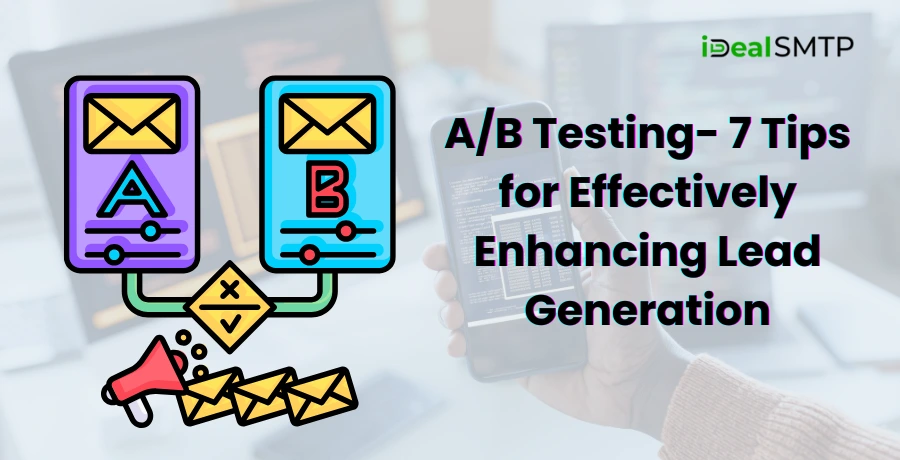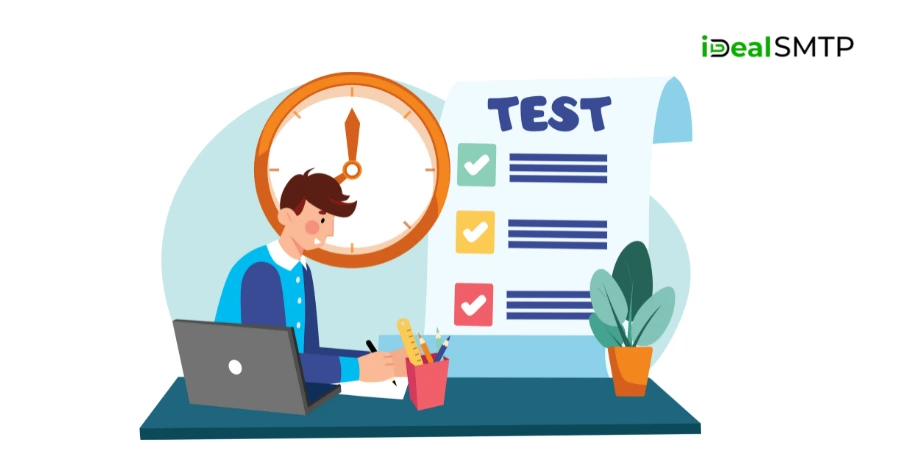In modern society, digital marketing it has become essential to go through emails, and disconnecting it is not enough. If you want to know your audience and get the most out of your email promotions, then you have to improve your strategy. To this end, the most effective strategy comes in handy through A/B Testing.

A/B testing or split testing compares two versions of an email to find out which is more effective. It is the process of altering some aspects of your email marketing services and messages and observing the effects when the different choices are applied.
Table of Contents
Pricing
| Trail Plan | Standard Plan | Premium Plan | Professional Plan |
| $50 | $145 | $185 | $225 |
| Sending Limit | Sending Limit | Sending Limit | Sending Limit |
| 1000 Emails/Hour | 1500 Emails/Hour | 3000 Emails/Hour | 5000 Emails/Hour |
What is A/B Testing?
A/B testing refers to the process you have one-half of your audience receives a particular email copy while the other half receives a different copy, the different copy is Version B. These tests could vary in any area with the help of which customer engagement could be improved, including subject lines, CTA buttons, content layout, or send time.
Once a certain number of tests have been made, the results of the various email are compared and the one with the highest performance is used for the remainder of the campaign.
7 A/B Testing Tips
We’ll explore seven crucial A/B testing tips that will help you enhance your lead generation efforts and drive better results.
Test Clear and Compelling Calls to Action (CTAs)
Yet again, the button is the single most important factor in helping you ‘convert’ your visitors into leads. A weak or incorrectly phrased CTA kills prospects and makes them unable to proceed to the next step in your sales channel.
When testing CTAs, try different variations in terms of:
- Text: Try out action words. For instance, you may replace the “Submit” button with the “Start” or “Claim Your Offer” button.
- Color: Contrasting colors to the rest of the layout can be as effective as a wholly different color for a CTA.
- Placement: Try and place CTAs at various areas (above the fold and at the footer), or even on the sticky’ sections that move with the content being scrolled.
This way you will be able to see which version has higher click-through rates and subsequently more leads.
Optimize Landing Page Headlines
Your headline is the first thing users see once they come to your web page and greatly determines whether they are gonna stay or not. Just like in copywriting, you will see a big difference when testing your headlines to boost your lead generation.
- Clarity: It is also important to ensure that your headline essentially delivers the message of the benefits of your offer. It comes down to the fact that if the headlines themselves are confusing or too broad, the visitors will merely leave.
- Relevance: Try some headlines that will appeal to the problem-solving and the needs of your target market.
- Urgency: When push comes to shove, one can include a sense of urgency or the scarcity factor in the messages and see the levels of conversion rise.
Try different emotional appeals and wordings of the call to action and offers to find out which kind of response you get.
Simplify Your Forms
Uncommon long forms that contain many fields can be an obstacle to lead acquisition in the process. Split testing various forms, their length, and format can help you to determine what is perfect for conversions without overloading the visitor.
- Field Count: Experiment with the specifications apart from the name, email, and phone number fields to see whether entries rise.
- Field Types: Compare different types of input fields (dropdowns out of text fields) to see which has better value.
- CTA Placement: Place your form together with the CTA button at the top and bottom of the page, and thereafter compare the level of attention being by visitors.
They saw that important instructions could make form completion complicated, and the simplicity of the form is what makes users fill the forms. The filter must be adjusted to the extent that you find the critical data to follow up on desired prospects.
Treat Different Offer Type Differently
At times, it’s the kind of offer you have given that can make or mar a visitor into offering his details. This would in a way provide the opportunity to establish a fact or a proof to the notion that modifying the type of an offer stimulates the highest response from the intended clients.
- Free Trials vs. Discounts: Compare the success rate of using a free trial or having the company’s first sale at a discount or with a promotional code.
- Ebooks vs. Webinars: Some of the types of audiences are those who prefer downloadable items such as ebooks while there are audiences who prefer to engage in formats such as webinars.
- Gated Content: Leads should be captured by gatting otherwise difficult-to-access information such as case studies and industry reports. Try different content offerings to know which one is more persuasive.
In this case, you are in a position to try out various methods of the lead magnets and determine which type of incentive is most likely to lead to the submission of contact information.
Use Social Proof to Build Trust
Social proof can become a major factor of conversion in your campaign, simply by making your offer more legitimate for the target audience. Experimentation on separate portions of social proof is useful since it boosts the number of leads generated by making them more credible.
- Customer Testimonials: Testimonials with text and video and long and short versions of it.
- Trust Badges: Self-explanatory, type some security badges, certifications, or mention media.
- Case Studies: The case when one can show some kind of example – a favorite case or successful story connected with your product or service, can also build confidence among the visitors.
By finding the right type of social proof and your target visitors, you know which elements are more promising to make people start taking action.
Test Different Visual Layouts and Design Elements
Your landing page or website’s design can be a success or a failure in creating a good first impression, and profitable leads. Testing multiple visual elements including pictures, placement, and fonts will lead you to create a better environment for the visitors.
- Image vs. Video: Find out if incorporating images or videos within a landing page leads to increased conversion rates. Motion pictures are effective in informing users how specific products can be used while images are suitable for informing users about simplicity.
- Page Layout: Change style perspectives – for instance, scroll with several lengthy contents and small ones to see which one is easier to use.
- Whitespace: When an element is important, there should be sufficient white space within its vicinity to influence the visitation to observe and follow the call to action button.
In conducting the studies above, you will get to know how different users use your site, and which designs create leads.
Optimize for Mobile
Most prospective buyers are using mobile devices to browse and shop and therefore your lead generation forms and landing pages must be mobile-friendly. Mobile A/B testing can act as an eye opener where you can come across some challenges that may maybe have been hindering visitors from converting.
- Responsive Design: Check how your landing page looks on a computer screen, on a tablet, and on a mobile device to see that layers look good and all the elements are visible.
- Button Sizes: On mobile specifically, your CTAs and forms must be large to be interacted with, and try different sizes of CTAs and forms.
- Load Speed: Check how long the indicated pages take to load on devices with a smaller screen size. People are more likely to bounce on a website that has a slow load time, and therefore it results in low POR.
Mobile optimization is an important aspect of user experience; it is always advisable to validate the mobile version of your pages and forms to improve results on every gadget.
Key Elements to Test in Your Emails
Email marketing is flexible and practically all elements within an email marketing campaign can be tested using A/B testing. Here are some common elements you might consider testing:

Subject Lines
The subject line is the first thing in an inbox that your recipients look at and they have lots to do with the opening of the entire email. What might look like a simple header, the length, tone, and even the use of emojis, can tremendously affect the open rates by experimenting with each.
Call-to-Action (CTA)
The Call to Action is what you need to convince your subscribers about what they need to do next. Experiments can be made with CTA text, such as “Buy Now” against “Shop Now”, buttons’ colors, sizes, and positions, to find out which ones generate the most clicks and shape more conversions.
Email Design and Layout
The visual appearance and style of writing of your email can also affect how you are received by the readers. These could include testing headers of different designs, where you place images or whether having multiple columns or a single-column layout is best for your audience.
Personalization
Employing such as simple element as the first name of the recipient in the email might go a long way in enhancing the response. Find out how adding a level of personalization to your campaign affects it – from talking directly to the recipient to giving specific content, or using segmentations.
Send Time and Frequency
When you send your emails can be as important as what you send in particular timing of the mailing list. This way you can try to test a variety of send-out frequencies or the time of a week for the email-sending process and find out when your readers are most active.
Email Content
The substance of your note – its word choice, length, and format – can also be surveyed. Even if you are going to write web content, it may not be bad to experiment with writing styles such as writing full-length content and short content, business-like language and colloquial one, and the like.
How to Conduct Effective A/B Tests
To ensure your A/B tests are effective, follow these key steps:
Define Your Objective
First, consider what each test means: what does it test and what is its purpose? Are you looking to drive open rates or click-through rates higher, or are you seeking more total conversions or conversion rates? Once cohesion is achieved among team members, enabling a singular objective, one would easily be able to gauge the results obtained and determine constructive changes to be made.
Test One Variable at a Time
Don’t combine different aspects in testing; test only one variable at a time. Grouping all the variables (subject line, CTA, and design) and running the test at once can lead to ambiguity. It is crucial that once a variable has been introduced into the experiment manipulate one variable at a time.
Deal with a Large Population Sample
A/B testing is most effective when you have a large population to work with; a population of users similar to that of your website. A small sample size has its drawbacks, including possible distortions of the outcome and a consequent reduction in the reliability of the conclusions that can be made.
Analyze Results Carefully
When the test is done, look at the results critically. Analyze open rates, click rates, conversion rates and each other parameter somehow connected with your test. Do not make a decision based on response rates alone; look at the overall performance of the campaign too.
Implement and Optimize
Once you have identified the winning version, make the changes made in the rest of your campaign. But, remember that it is always important to experiment with certain aspects of your email marketing strategy more ever.
The Benefits of A/B Testing
- Data-Driven Decisions: Through A/B testing, we can reduce marketing decision-making from simple guesswork and reliance on intuition. This results in enhanced outcomes and optimum campaigning.
- Improved Engagement: When you frequently experiment with your email promoting messages you protect the account’s integrity aiming it to appeal to the audience most of the time, and hereby receiving higher open rates, more clicks on links, and simply higher results.
- Higher Conversion Rates: Small changes in verb choices, words, or phrases can make a lot of difference in the conversion rate and click-through rates. Thanks to A/B testing it is possible to find these improvements and achieve the highest possible effectiveness of your campaigns.
- Enhanced Customer Experience: Exploring the various types of content, layout, and customization provides you with the best emails for your audience that will help improve their experience with your brand.
Conclusion
A/B testing should always come into the picture as a critical weapon in the tool belt of any marketer who would like to optimize his/her email marketing campaign in a bid to get the most optimum results.
So, constantly experimenting with some of the variables, evaluating them, and fine-tuning your emails, you will be able to open a new performance level for your company, a new level of interaction with the audience, and, thus, new results for your campaign. If you’re not currently using A/B tests on your emails, then there is no better time than the present to begin – your audience as well as your profits will appreciate it!







